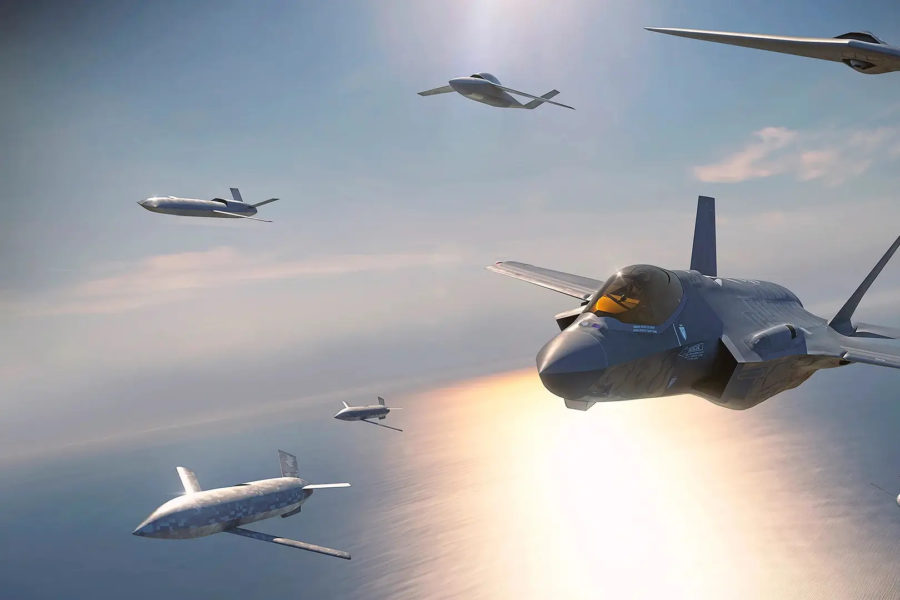The Air Force has mapped out spending requests totaling $5.8 billion for research and development of Collaborative Combat Aircraft through fiscal 2028—$6 billion counting other experimentation tied to the program. And budget documents released by the service also suggest a “spectral warfare” platform will be one of the first variants of the autonomous drones.
The funding is contained within the broader Next Generation Air Dominance (NGAD) program, and consolidates previous research, development, test, and evaluation line items for Autonomous Collaborative Platforms and Autonomous Collaborative Technologies. The NGAD effort overall—including CCAs—is projected for $16.23 billion over the future years defense program.
The CCA figure is in line with Air Force Secretary Frank Kendall’s assertion at the AFA Warfare Symposium in early March that “very, very significant” funding is being requested for the program, which will produce robotic wingmen to crewed fighters. They are meant to build USAF combat capacity without exacerbating the fighter pilot shortage, and do so at what Kendall has called an “affordable” price.
Kendall announced at AWS that he has set 1,000 CCAs as a “planning figure” around which service planners can develop CCA operational concepts, but he subsequently has said the actual number of aircraft could be far greater than that figure, which was derived from a notional two CCAs each to escort 200 NGAD manned fighters and 300 F-35s.
Kendall has also said the ultimate number of CCAs could be as high as five for every crewed fighter. He said the program will be competitive, but at the McAleese defense conference last week, suggested the Air Force will choose a single platform which can accept a variety of modular mission payloads.
The budget justifications suggest CCAs will be introduced operationally around 2030.
The CCA spending plan begins with $392.2 million in fiscal year 2024. It rises to $513.8 million in FY 2025, but takes an unexplained dip to $245.9 million in 2026. After that, though, it more than sextuples to $1.64 billion in 2027, then nearly doubles again to $3.03 billion in 2028.
The NGAD budget documents noted a particular emphasis on a “spectral dominance platform” CCA, which sounds like a programmatic descendent of the mid-2010s “Penetrating Electronic Attack” program, also associated with what has become NGAD.
During a March 22 Mitchell Institute event, Gen. Mark D. Kelly, head of Air Combat Command, said the the operational concept of the spectral dominance platform is still being determined.
“I think those are discovery items that will come out when we do our first developmental tests and operational tests and see what’s in the art of the possible going forward,” said Kelly. He added that whether the platform is a pure jammer versus an electronic attack aircraft that can also fire anti-radiation missiles is “all … in the discussion,” and that the developmental testing will reveal “the solution we’re looking for.”
At AWS, Kelly said electronic warfare was likely the most “urgent” mission for CCAs, listing sensing, jamming, and “signals intelligence” as his top needs for the platform. Size, weight and power requirements will also have a lot to do with whether a CCA can perform the mission, Kelly added.
“I think we’ll iterate from there,” he said at the conference.
Kendall said at AWS that the FY 2024 budget would contain money for experimentation using existing aircraft as stand-ins for the CCAs, in order to explore operational concepts and further refine requirements. Toward that end, there’s $50 million in the 2024 request for a new start called “Viper Experimentation and Next-Gen Operations Model (VENOM),” which will conduct “early risk reduction” on CCAs using autonomous technology aboard crewed F-16 aircraft as surrogates for CCAs.
Another $72 million funds an “Experimental Operations Unit” which will test-fly CCA concepts and flesh out the manpower footprint, doctrine, training and facilities needed to implement CCA technologies.
Yet another $51.7 million involves transition of the Air Force’s Skyborg autonomous flight technology to CCA platforms.
In budget justification documents, the Air Force said CCA activities “will include the employment of digital acquisitions through the application of digital engineering, agile software development, and open system architectures.” The requested funds would invest in “information technology/test/training infrastructure” as well as “operational concept exploration, technology studies, multi-domain integration, operational assessments, architecture development, and multi-level prototyping,” along with program management support.
All of this will go toward reducing risk and maturing CCA concepts “and air superiority-related technologies in support of the NGAD family of systems.”

